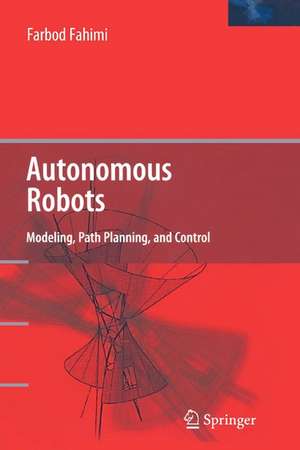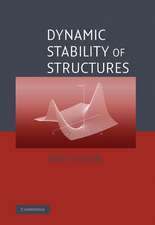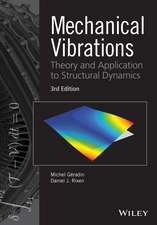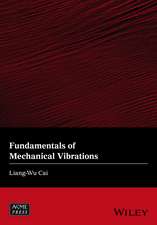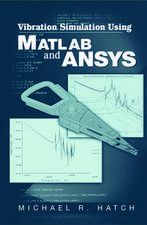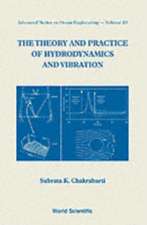Autonomous Robots: Modeling, Path Planning, and Control
Autor Farbod Fahimien Limba Engleză Paperback – 29 oct 2010
Engineers have taken advantage of the extra mobility of the advanced robots to make them work in constrained environments, ranging from limited joint motions for redundant (or hyper-redundant) manipulators to obstacles in the way of mobile (ground, marine, and aerial) robots.
Since these constraints usually depend on the work environment, they are variable. Engineers have had to invent methods to allow the robots to deal with a variety of constraints automatically. A robot that is equipped with those methods is called an Autonomous Robot.
Autonomous Robots: Kinematics, Path Planning, and Control covers the kinematics and dynamic modeling/analysis of Autonomous Robots, as well as the methods suitable for their control. The text is suitable for mechanical and electrical engineers who want to familiarize themselves with methods of modeling/analysis/control that have been proven efficient through research.
| Toate formatele și edițiile | Preț | Express |
|---|---|---|
| Paperback (1) | 731.35 lei 6-8 săpt. | |
| Springer Us – 29 oct 2010 | 731.35 lei 6-8 săpt. | |
| Hardback (1) | 1145.90 lei 6-8 săpt. | |
| Springer Us – 4 dec 2008 | 1145.90 lei 6-8 săpt. |
Preț: 731.35 lei
Preț vechi: 891.88 lei
-18% Nou
Puncte Express: 1097
Preț estimativ în valută:
139.96€ • 145.58$ • 115.55£
139.96€ • 145.58$ • 115.55£
Carte tipărită la comandă
Livrare economică 14-28 aprilie
Preluare comenzi: 021 569.72.76
Specificații
ISBN-13: 9781441934901
ISBN-10: 1441934901
Pagini: 360
Ilustrații: XVIII, 340 p. 86 illus.
Dimensiuni: 155 x 235 x 19 mm
Greutate: 0.55 kg
Ediția:Softcover reprint of hardcover 1st ed. 2009
Editura: Springer Us
Colecția Springer
Locul publicării:New York, NY, United States
ISBN-10: 1441934901
Pagini: 360
Ilustrații: XVIII, 340 p. 86 illus.
Dimensiuni: 155 x 235 x 19 mm
Greutate: 0.55 kg
Ediția:Softcover reprint of hardcover 1st ed. 2009
Editura: Springer Us
Colecția Springer
Locul publicării:New York, NY, United States
Public țintă
ResearchCuprins
Redundant Manipulators.- Hyper-Redundant Manipulators.- Obstacle Avoidance Using Harmonic Potential Functions.- Control of Manipulators.- Mobile Robots.- Autonomous Surface Vessels.- Autonomous Helicopters.
Textul de pe ultima copertă
It is at least two decades since the conventional robotic manipulators have become a common manufacturing tool for different industries, from automotive to pharmaceutical. The new generation of robots are now being developed that can be categorized in two groups; redundant (and hyper-redundant) manipulators, and mobile (ground, marine, and aerial) robots. These groups of robots, known as advanced robots, have more freedom for their mobility, which allows them to do tasks that the conventional robots cannot do. Engineers have taken advantage of the extra mobility of the advanced robots to make them work in constrained environments, ranging from limited joint motions for redundant (or hyper-redundant) manipulators to obstacles in the way of mobile (ground, marine, and aerial) robots.
Autonomous Robots: Modeling, Path Planning, and Control covers the kinematics and dynamic modeling/analysis of Autonomous Robots, as well as the methods suitable for their control. Drawing upon years of experience and using numerous examples and illustrations, Farbod Fahimi discusses:
Autonomous Robots: Modeling, Path Planning, and Control covers the kinematics and dynamic modeling/analysis of Autonomous Robots, as well as the methods suitable for their control. Drawing upon years of experience and using numerous examples and illustrations, Farbod Fahimi discusses:
- The application of autonomous robots including but not limited to redundant and hyper-redundant manipulators, and ground, marine, and aerial robots.
- Position and velocity kinematics of redundant and hyper-redundant manipulators.
- Obstacle avoidance in 2D and 3D workspace using the potential field method.
- Kinematic and dynamic models of autonomous robots.
- Control methods such as PID, feedback linearization, sliding modes as applied to autonomous robots.
Caracteristici
Discusses the application of Advanced Robots (redundant and hyper-redundant manipulators, and ground, marine, and aerial robots) with examples such as robotic helicopters for surveillance, aerial photography, farm spraying, high-end cars that park themselves, and robotic vacuum cleaners Presents the theoretical tools for analyzing the dynamics of and controlling Autonomous Robots in a form comprehensible for students and engineers Provides a complete overview of control methods including but not limited to PID control, feedback linearization and sliding mode control Contents are unique and present material never gathered within one book and never presented in a form useful to students and engineers Presents comprehensive examples addressing the modeling and control of Autonomous Robots, and several exercise problems and term projects. Includes supplementary material: sn.pub/extras
